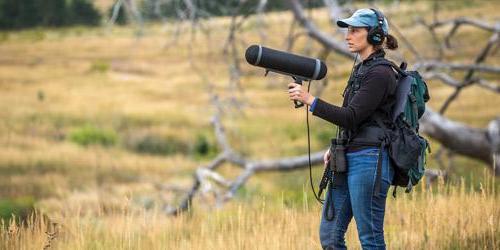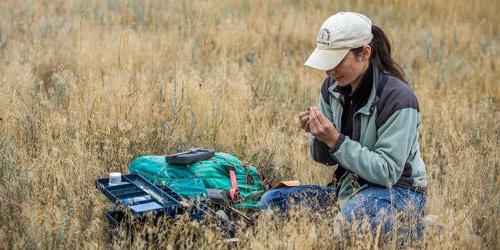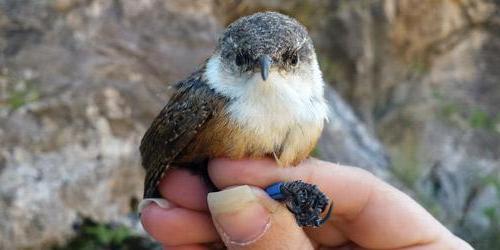听力课
UNC researchers capture the songs and study the behavior of canyon and rock wrens
黛比·皮特纳·摩尔斯著
It’s a gray fall morning at Bobcat Ridge Natural Area just west of Loveland. UNC生物学
professor Lauryn Benedict, doctoral student Nadje Najar and master’s student TJ Hathcock
walk along a high path, then stop as Hathcock lifts his binoculars and looks toward
露出地面的岩石.
Somehow, amidst the myriad natural sounds drifting over the landscape, he’s picked
out the sound of a rock wren, like a miner sifting for gold. 他的听觉很灵敏。
to the musical notes of this small, brown bird, and Benedict and Najar hear it too,
举起自己的双筒望远镜.
This is a bird species that all three of the scientists know well. 本尼迪克
studying the rock wren and its cousin, the canyon wren, for six years. 纳贾尔刚刚
returned to Greeley after a summer-long study of rock wrens that traversed from Texas
to Montana, and Hathcock has spent the last two summers scaling rocky outcroppings
to play rock and canyon wren recordings and capture their sounds.
The iconic song of the canyon wren is arguably the soundtrack of the American West,
lifting and curling and cascading along canyons, boulder fields and cliffs that range
from central Mexico to just south of the U.S./加拿大边境. 磐石之歌
wren is less well known, but is also part of the acoustic fabric of rocky western
栖息地.
While Benedict, Najar and Hathcock each focus on different questions about canyon
wrens and rock wrens, their research interconnects as they study social behavior and
communication, as well as habitat use, in these cliff-associated wren species.
The songs of canyon and rock wrens haven’t been studied much, so the team’s work at
联合国军司令部是对新领域的一次重要尝试. They’re looking at how habitat may affect
song, the differences in vocalization of males and females, how they communicate,
how birdsong has evolved and how the birds respond to intruders.
“Animals do things differently,” says Najar, pointing out that rock wrens she studies
以不同的方式应对入侵者. “有些人一开始不会暴露自己. 其他人
在. You get extremes of aggression versus non-confrontation.”
Although canyon wrens and rock wrens are closely related, a curious and significant
difference between the two species has to do with the number of songs in their repertoires.
While a single canyon wren sings about five different song types, a rock wren far
surpasses that, with a loquacious 120 songs. 为什么会有两个近亲呢
evolved so differently from a communication standpoint? 这个问题可以
bring insight into how bird behavior and communication are shaped by factors like
social context, habitat and population density.
To investigate these issues, Benedict and her team record birdsong in the field, then
use technology to translate sound into a visual representation of song pitch, duration
and changes that are often too subtle for the human ear. 得到的光谱
paint a picture that’s helping sort out small differences in communication from one
鹪鹩到下一个.
Individual birds of the same species all sing songs that recognizably belong to that
species, much the same way that people speaking a single language all use the same
单词和短语. Nevertheless, there are differences between individuals in terms
of the particular song types they use and the way they sing them.
As among humans, these differences can arise from geography — populations that are
distant from each other often have different “dialects” or “accents” — or they can
源于个体差异. Benedict, Najar and Hathcock are all working to
understand some of the individual level differences that cause the songs of each bird
在一个社区听起来很独特.
Studying how and why these little brown wrens communicate can be an exercise in patience.
Describing a typical day in the field, Hathcock says he’s often awake at 4 a.m.,花
about an hour driving to the field, then hikes in (loaded with recording equipment,
binoculars and a backpack), and sets up and waits (sometimes for hours) for the show’s
明星登场. 但这是他热爱的工作. And it’s a love for science that he hopes
to share once he finishes his master’s degree in Biology by becoming a high school
老师. “My generation is so tech-oriented,” he says. “我们真的在努力
孩子们离开了教室.”
Sparking an interest in the natural world may just be one of the benefits of studying
鸟类的交流和行为. Scientists are also looking at the effects 的鸟鸣声
on humans — from lowering anxiety to improving study skills and concentration.
Along the rocky shoulders of Colorado’s Bobcat Ridge, distanced from the noise and
pervasive technology of everyday life, it’s not hard to imagine the therapeutic benefits
的鸟鸣声. It’s a lesson in listening and connecting — in being immersed in the
landscape rather than passing through it, finding the current of music that slips
穿越自然世界.







